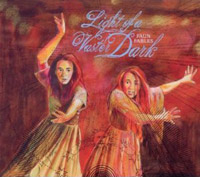Scott Morrow is ALARM’s music editor. Patrick Hajduch is a very important lawyer. Each week they debate the merits of a different album.
 Faun Fables: Light of a Vaster Dark (Drag City, 11/16/10)
Faun Fables: Light of a Vaster Dark (Drag City, 11/16/10)
Faun Fables: “Light of a Vaster Dark”
[audio:https://alarm-magazine.com/wp-content/uploads/2011/01/Faun_Fables_Light_of_a_Vaster_Dark.mp3|titles=Faun Fables: “Light of a Vaster Dark”]
Morrow: Borne of principal songwriter Dawn McCarthy, Faun Fables is a powerful, somber, and multifaceted brand of neofolk songs and theatrical performance. The group’s works also are developed by co-conspirator Nils Frykdahl of Sleepytime Gorilla Museum, and their breadth of instrumentation comes courtesy of assorted guests.
Light of a Vaster Dark is Faun Fables’ first album in four-and-a-half years, and it again is led by the dynamic vocal interplay of McCarthy, Frykdahl, and others — blending elements of the 1950s/’60s American folk revival, medieval and Celtic music, and the catchall “psychedelic folk.”
Though McCarthy’s clear intonation and wavering vibratos are the real star, Frykdahl’s backing vocals add a necessary baritone presence, and the album’s range of sounds is just as vital. Guitars, violin, flute, bass clarinet, autoharp, Theremin, and homemade instruments all offer different sonic flavors behind a vocal presence that can sound a little homogenous from time to time.
Hajduch: The whole flute/autoharp accompaniment and the melodrama of the vocals is maybe a little much, but the melodies are strong and the vocals are recorded extremely well. The melodies remind me more than a little of Ulver‘s classic Kveldssanger — both use rock tonalities and circular, chanting structures in a similar approach to folk. Faun Fables also uses these elements towards a proggier, more melodramatic end — “Housekeeper” returns to a chorus a few times, but over its six minutes, it diverts its attention to other ideas as it sees fit.
The album is at its most interesting when it gets furthest from the “freak folk” mantle. The harmonica of “Parade” and the clanging drone of “Bells for Ura” make for a nice break from some of the longer-form folk-prog pieces. The album is also broken up with several instrumental interludes, which help to pace an album that would otherwise feel relentless. If you like long-form, intricately orchestrated, progressive, unfolding folk tunes that may lay it on a little thick at times, then this is arguably too much of a good thing.
Morrow: Indeed. It’s not for everyone, but if you already love forceful, harmonized folk vocals a la Charming Hostess and Jewlia Eisenberg, you’ll love Faun Fables. The Sleepytime fan in me would love to hear more of Frykdahl’s vocals, but his support role works well as it is, and he’s already credited as the second of the band’s two composers. I feel like this was a little overlooked (at least by me) as it was released in advance of the holiday season, so be sure to check it out if you missed it too.

